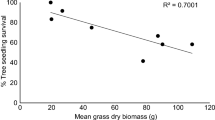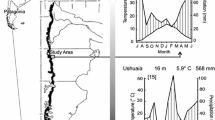Summary
The effects of the spatial pattern of defoliation within a tussock grass, Agropyron desertorum, were investigated at a semiarid field site. In the middle of the spring growing season (mid-May), tussocks were clipped in repeatable defoliation patterns, and the regrowth of foliage was monitored. These clipping patterns involved removal of foliage from different locations within the tussock, but the total amount of foliage removed was held constant. Active meristems were left intact in all cases. The spatial pattern of defoliation affected both initial rates of tussock regrowth and total growing-season aboveground biomass production. When leaves were removed low in the tussock (older leaves), regrowth was greater than after removal of the same quantity of foliage high in the canopy (younger leaves). These differences in regrowth were due to differences in the rate of new tissue production rather than differences in the timing of senescence. The results were consistent over two years even though aboveground production differed considerably between years. The interaction of the spatial pattern and timing of defoliation was also studied by clipping additional plants in late May. The timing of defoliation affected the relative influence of different defoliation patterns on regrowth. In those defoliation patterns where active meristems were not removed in the late-May clipping, there were no differences in regrowth of tussocks which had either upper or lower foliage removed. However, because the grass culms had elongated by late May, active meristems were higher and were removed by one of the defoliation pattern treatments (a uniform clipping). This resulted in much less regrowth. Differences in the effects of clipping patterns applied in late May were associated with this removal of active meristems. Whereas, differences among clipping treatments following the earlier mid-May defoliation were probably a result of changes in factors which affected tussock carbon gain (e.g., light interception, foliage age structure). In either case, the spatial pattern of defoliation within a tussock grass clearly had significant effects on aboveground regrowth.
Similar content being viewed by others
References
Belsky AJ (1986) Does herbivory benefit plants? A review of the evidence. Am Nat 127:870–892
Bentley S, Whittaker JB (1979) Effects of grazing by a Chrysomelid beetle, Gastrophysa viridula, on competition between Rumex obtusifolius and Rumex cripus. J Ecol 67:79–90
Binnie RC, Chestnut DMB, Murdoch JC (1980) The effect of time of initial defoliation and the height of defoliation on the productivity of perennial ryegrass swards. Grass For Sci 35:267–273
Briske DD (1986) Plant response to defoliation: morphological considerations and allocation priorities. In: Joss PJ, Lynch PW, Williams OB (eds) Rangelands: a resource under siege. Proceedings of the 2nd International Rangeland Congress. Australian Acad Sci, Canberra, pp 425–427
Brown RH, Cooper RB, Blaser RE (1966) Effects of leaf age on efficiency. Crop Sci 6:206–209
Caldwell MM (1984) Plant requirements for prudent grazing. In: Developing strategies for rangeland management. Westview Press, Boulder, CO, pp 117–152
Caldwell MM, Richards JH, Johnson DA, Nowak RS, Dzurec RS (1981) Coping with herbivory: photosynthetic capacity and resource allocation in two semiarid Agropyron bunchgrasses. Oecologia 50:14–24
Caldwell MM, Dean TJ, Nowak RS, Dzurec RS, Richards JH (1983) Bunchgrass architecture, light interception, and wateruse efficiency: assessment by fiber optic point quadrats and gas exchange. Oecologia 59:178–184
Caldwell MM, Richards JH, Manwaring JH, Eissenstat DM (1987) Rapid shifts in phosphate acquisition show direct competition between neighbouring plants. Nature 327:615–616
Crawley MJ (1983) Herbivory: The dynamics of animal-plant interactions. Studies in ecology, vol 10, Blackwell Sci Publ, Boston
Dirzo R (1984) Herbivory: a phytocentric overview. In: Dirzo R, Sarukhan J (eds) Perspectives on plant population ecology. Sinauer Assoc, Sunderland, Mass, pp 141–165
Dyer MI, Detling JK, Coleman DC, Hilbert DW (1982) The role of herbivores in grasslands. In: Estes JR, Tyrl RJ, Brunken JN (eds) Grasses and grasslands: systematics and ecology. Univ Oklahoma Press, Norman
Gold WG, Caldwell MM (1989a) The effects of the spatial pattern of defoliation on regrowth of a tussock grass. II. Canopy gas exchange. Oecologia (in press)
Gold WG, Caldwell MM (1989b) The effects of the spatial pattern of defoliation on regrowth of a tussock grass. III. Photosynthesis, canopy structure, and light interception. Oecologia (in press)
Hansen JD (1987) Feeding site selection by Irbisia pacifica (Hemiptera: Miridae) on four cool-season western range grasses. J Kan Entomol Soc 60:316–323
Hartnett DC, Bazzaz FA (1986) Leaf demography and plant-insect interactions: a further comment. Am Nat 127:561–564
Janzen DH (1979) New horizons in the biology of plant defenses. In: Rosenthal GA, Janzen DH (eds) Herbivores: their interaction with secondary plant metabolites. Academic Press, New York, pp 331–350
Kulman HM (1965) Effects of artificial defoliation of pine on subsequent shoot and needle growth. Forest Sci 11:90–98
Ludlow MM, Charles-Edwards DA (1980) Analysis of regrowth of a tropical grass/legume sward subjected to different frequencies and intensities of defoliation. Aust J Agric Res 31:673–692
McKey D (1979) The distribution of secondary compounds within plants. In: Rosenthal GA, Janzen DH (eds) Herbivores: their interaction with secondary plant metabolites. Academic Press, New York, pp 56–134
McNaughton SJ (1983) Compensatory plant growth as a response to herbivory. Oikos 40:329–336
McNaughton SJ, Wallace LL, Coughenour MB (1983) Plant adaptation in an ecosystem context: effects of defoliation, nitrogen, and water on the growth of an African C4 sedge. Ecology 64:307–318
Mendoza A, Pinero D, Sarukhan J (1987) Effects of experimental defoliation on growth, reproduction and survival of Astrocaryum mexicanum. J Ecol 75:545–554
Mooney HA, Gulmon SL (1982) Constraints on leaf structure and function in reference to herbivory. Bioscience 32:198–206
Norton BE, Johnson PS (1983) Pattern of defoliation by cattle grazing crested wheatgrass pastures. In: Smith JA, Hays VW (eds) Proceedings of the XIV International Grassland Congress, Westview Press, Boulder, Colo, pp 462–464
Nowak RS, Caldwell MM (1984) A test of compensatory photosynthesis in the field: implications for herbivory tolerance. Oecologia 61:311–318
Olson BE, Richards JH (1988) Tussock regrowth after grazing: intercalary meristem and axillary bud activity of tillers of Agropyron desertorum. Oikos 51:374–382
Richards JH, Caldwell MM (1985) Soluble carbohydrates, concurrent photosynthesis and efficiency in regrowth following defoliation: a field study with Agropyron species. J Appl Ecol 22:907–920
Stickler FC, Pauli AW (1961) Leaf removal in grain sorghum. I. Effects of certain defoliation treatments on yield and components of yield. Agron J 53:99–102
Thornley JHM (1976) Mathematical models in plant physiology. Academic Press, New York
Watson MA, Casper BB (1984) Morphogenetic constraints on patterns of carbon distribution in plants. Ann Rev Ecol Syst 15:233–258
Author information
Authors and Affiliations
Rights and permissions
About this article
Cite this article
Gold, W.G., Caldwell, M.M. The effects of the spatial pattern of defoliation on regrowth of a tussock grass. Oecologia 80, 289–296 (1989). https://doi.org/10.1007/BF00379029
Received:
Issue Date:
DOI: https://doi.org/10.1007/BF00379029




